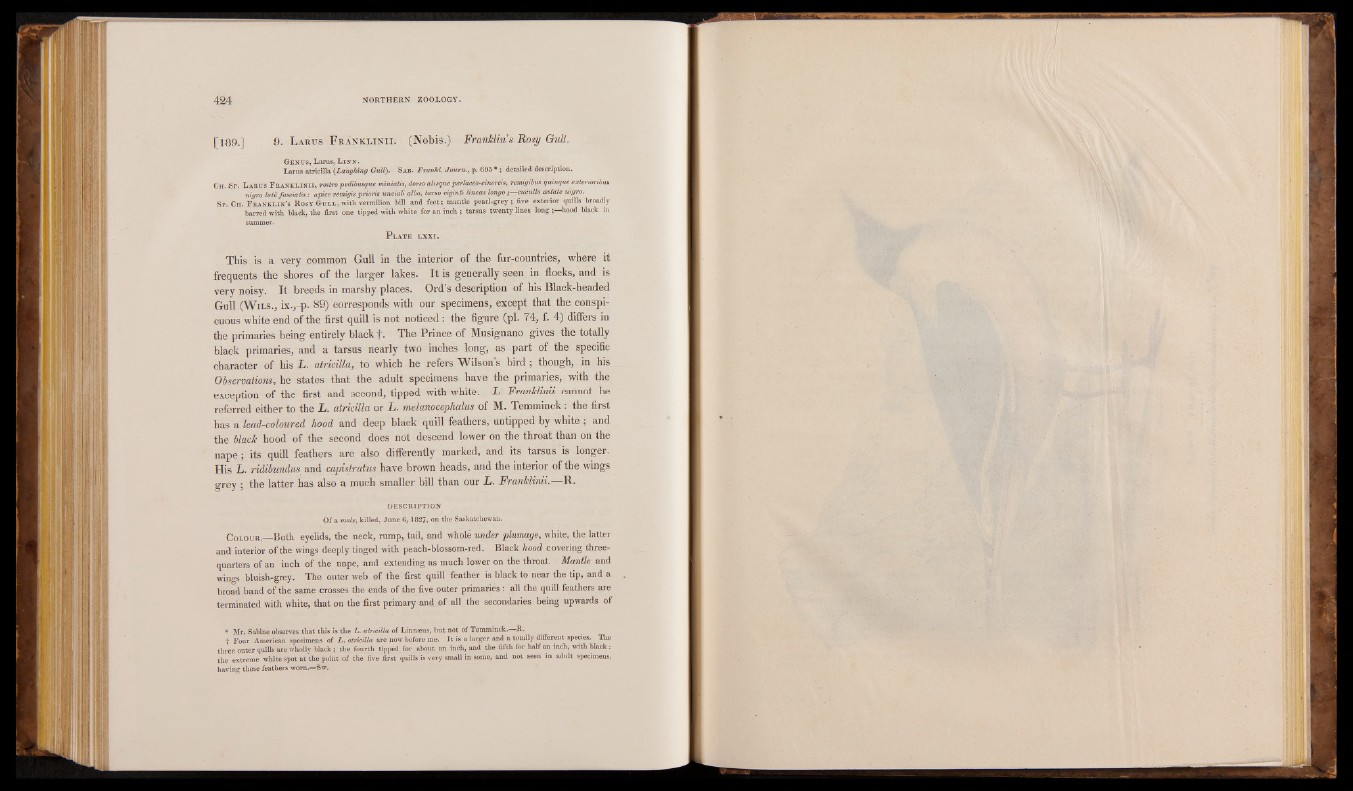
|“ 189.] .9. L a r u s F r a n k l in ii. (Nobis.) Franklins Rosy Gull.
Genus, Larus, Lin n .
Larus atricilla (Laughing Gull). Sab. FranU. Joum., p. 695 * ; detailed description.
Ch. Sp . Larus F ranklinii, rostro pedibusque miniatis, dorso alisque perlaceo-cinereis, remigibns quinque extenoribus
nigro lath fasciatis: apice remigis prioris unciali albo, tarso viginti lineas longo ; cucullo (estate nigro.
Sp. Ch . F r a n k l in ’s R o st Gu l l , w ith vermilion bill and feet; mantle pearl-grey; five exterior quills broadly
barred w ith black, the first one tipped with w hite for an inch ; tarsus tw enty lines lo n g;—hood black in
summer.
P late lx x i.
This is a very common Gull in the interior of the fur-countries, where it
frequents the shores of the larger lakes. It is generally seen in flocks, and is
very noisy. It breeds in marshy places. Ord’s description of his Black-headed
Gull (W il s ., ix.,-p. 89)' corresponds with our specimens, except that the conspicuous
white end of the first quill is not noticed: the figure (pi. 74, f. 4) differs in
the primaries being entirely black f. The Prince of Musignano gives the totally
black primaries, and a tarsus nearly two inches long, as part of the specific
character of his L . atricilla, to which he refers Wilson’s bird; though, in his
Observations, he states that the adult specimens have the primaries, with the
exception of the first and second, tipped with white. L. FranHinii cannot be
referred either to the L . atricilla or L . melanocephalus of M. Temminck: the first
has a lead-coloured hood and deep black quill feathers, untipped by white ; and
the black hood of the second does not descend lower on the throat than on the
nape; its quill feathers are also differently marked, and its tarsus is longer.
His L. ridibundus and cajyistratus have brown heads, and the interior of the wings
grey ; the latter has also a much smaller bill than our L . Franklinii.—R.
DESCRIPTION
Of a male, killed, June 6, 1827, on the Saskatchewan.
Colour.__Both eyelids, the neck, rump, tail, and whole under plumage, white; the latter
and interior of the wings deeply tinged with peach-blossom-red. Black hood covering three-
quarters of an inch of the nape, and extending as much lower on the throat. Mantle and
wings bluish-grey. The outer web of the first quill feather is black to near the tip, and a
broad band of the same crosses the ends of the five outer primaries : all the quill feathers are
terminated with white, that on the first primary and of all the secondaries being upwards of
* Mr. Sabine observes that this is the L. atricilla of Linnaeus, but not of Temminck.—R.
t Four American specimens of L. atricilla are now before me. It is a larger and a totally different species. The
three outer quills are wholly black; the fourth tipped for about an inch, and the fifth for half an inch, with black:
the extreme white spot at the point of the five first quills is very small in some, and not seen in adult specimens,
having these feathers worn.—Sw.